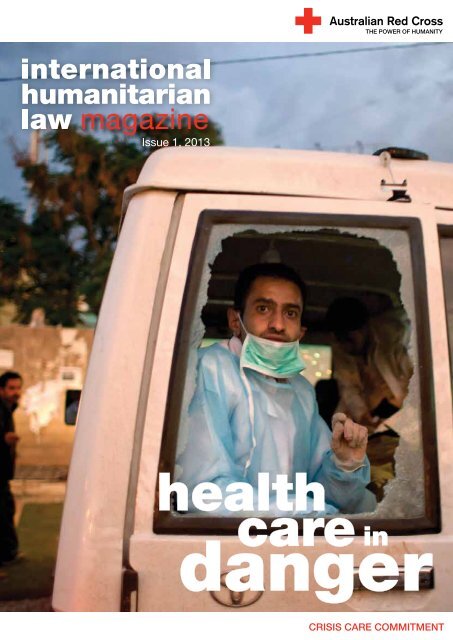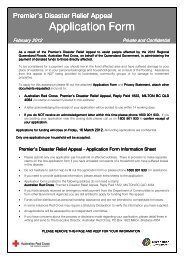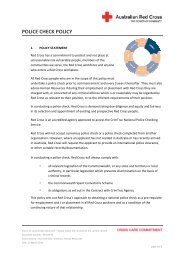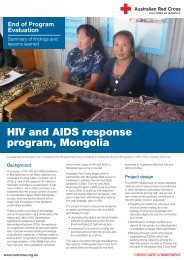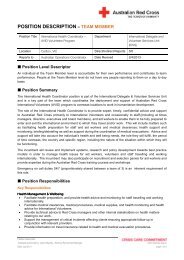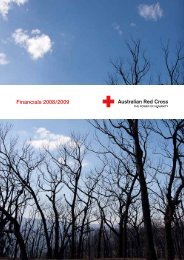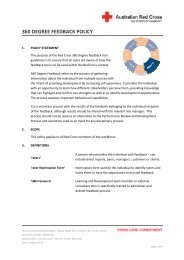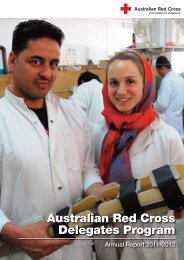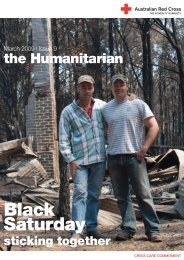Health Care in Danger - Australian Red Cross
Health Care in Danger - Australian Red Cross
Health Care in Danger - Australian Red Cross
- No tags were found...
Create successful ePaper yourself
Turn your PDF publications into a flip-book with our unique Google optimized e-Paper software.
magaz<strong>in</strong>eIssue 1, 2013healthcare<strong>in</strong>danger
thedistortion of conflict:health services<strong>in</strong>severely disruptedenvironmentsPeter Hill (correspond<strong>in</strong>gauthor) is an AssociateProfessor <strong>in</strong> the Schoolof Population <strong>Health</strong>at the University ofQueensland.This paper is an abridged versionof a paper prepared by PeterHill, Enrico Pavignani, MarkusMichael, Maurizio Murru andMark E Beesley.Sa’ada, Yemen, 2007. Patients wait<strong>in</strong>g <strong>in</strong>front of the tent of the primary health carecentre project organised by the ICRC andYemeni <strong>Red</strong> Crescent Society.Photo: ICRC/P. DudaThe impact of conflict on healthprofessionals is, at last, be<strong>in</strong>g openlyexam<strong>in</strong>ed. But <strong>in</strong> addition to the directimpact on <strong>in</strong>dividual lives, conflict alsoimpacts on health systems as a whole.The distortions that it causes last wellbeyond the cessation of violence andbecome structured <strong>in</strong>to the systemsthemselves. In many cases, thesehealth systems are already fragileand the problems they face are oftencompounded, but are rarely new. Yet,even for those vulnerable systemsconflict may provide opportunities forchange and, <strong>in</strong> fact, is an imperativefor change.Recent research by the Universityof Queensland has exam<strong>in</strong>ed healthservices <strong>in</strong> severely disruptedenvironments: Afghanistan, CentralAfrican Republic, the DemocraticRepublic of the Congo (DRC), Haiti,Palest<strong>in</strong>e and Somalia. The f<strong>in</strong>d<strong>in</strong>gsof this research po<strong>in</strong>t to the diffuseand pervasive penetration of violence,affect<strong>in</strong>g each of the six build<strong>in</strong>g blocksthat make up a health system.<strong>Health</strong> servicesWhile the pre-exist<strong>in</strong>g coverage ofhealth services is often poor, servicescontract even further away from activeconflict – as <strong>in</strong> Afghanistan – and tend toconcentrate development resources <strong>in</strong>the limited number of secure prov<strong>in</strong>ces,<strong>in</strong>evitably privileg<strong>in</strong>g their developmentover the long term. The mal-distributionof staff exacerbates exist<strong>in</strong>g disparities,with those who have portable skills oftentak<strong>in</strong>g advantage of these to migrate.The health services gaps, however,do not necessarily rema<strong>in</strong> a vacuum.They are filled by health workerswith limited, <strong>in</strong>complete or expeditedtra<strong>in</strong><strong>in</strong>g, retired staff, traditionalpractitioners, volunteers andquacks. The services that will thenbe available to the community willdepend on which staff rema<strong>in</strong>, theavailability of drugs, accessible supplyl<strong>in</strong>es and adaptability to the dynamicsof conflict. Preventive programsbecome more difficult to susta<strong>in</strong>;immunisation and child healthservices may be curtailed due to therisks of congregat<strong>in</strong>g, or threats tostaff dur<strong>in</strong>g outreach activities.Human resourcesThe health sector itself is <strong>in</strong>creas<strong>in</strong>glya focus for violence, for a varietyof complex reasons. In conflictswhere the state is be<strong>in</strong>g challenged,it may be targeted through itssocial services; destroy<strong>in</strong>g health<strong>in</strong>frastructure underm<strong>in</strong>es l<strong>in</strong>ks togovernment. The loss of humanresources through death and<strong>in</strong>jury, relocation and migrationcontributes to the distortion of thehealth workforce, exacerbat<strong>in</strong>galready problematic rural-urban maldistribution.Tra<strong>in</strong><strong>in</strong>g is often patchyand of poor quality, with qualificationswhose standards are difficult toconfirm, and the resultant workforceis frequently bloated and underskilled.F<strong>in</strong>anc<strong>in</strong>gIn conflict, local f<strong>in</strong>anc<strong>in</strong>g for healthis frequently reduced, with securityconsum<strong>in</strong>g a disproportionatepart of the budget – military healthservices the one potential exception.State fund<strong>in</strong>g frequently contractsto (irregularly) cover salaries alone,with limited allocations for drugsand outreach activities. Out-ofpocketexpenditure rapidly becomes<strong>in</strong>tegral to health service provision:departmental health services <strong>in</strong> Haitiare heavily dependent on user-fees; <strong>in</strong>Afghanistan, patients prefer to spendtheir money <strong>in</strong> the private for-profitsector; with state f<strong>in</strong>anc<strong>in</strong>g for health<strong>in</strong> the DRC among the lowest <strong>in</strong> theworld, district adm<strong>in</strong>istrations, oftenwith no other sources of f<strong>in</strong>ancialsupport, rely on user fees to supportthe <strong>Health</strong> Zone with a cut sent on tothe Prov<strong>in</strong>cial <strong>Health</strong> Directorate.Drugs, vacc<strong>in</strong>es andtechnologyConflict and its aftermath arecharacterised by a conspicuouscommodification of health, with drugs,vacc<strong>in</strong>es and technology provid<strong>in</strong>gan economic rationale for susta<strong>in</strong><strong>in</strong>gprivate provision of selected services<strong>in</strong> the absence of the state. Porousborders <strong>in</strong> Somalia have allowed<strong>in</strong>creased importation of drugs froma range of sources, <strong>in</strong>clud<strong>in</strong>g <strong>in</strong>formaland at times illegal elements. Thelimited regulation means that poorquality drugs, or fraudulent drugs,many with European brand-names,have easy access. Without prescrib<strong>in</strong>gcontrols, self treatment results <strong>in</strong><strong>in</strong>adequate therapy and the lack ofWestern medic<strong>in</strong>es <strong>in</strong> some conflictlocations means that traditionalmedic<strong>in</strong>es are frequently substituted.<strong>Health</strong> <strong>in</strong>formationThe <strong>Health</strong> Information Systemis frequently vulnerable prior toconflict, but further compromisedthrough loss or relocation of the staffresponsible for record<strong>in</strong>g, report<strong>in</strong>gor analys<strong>in</strong>g <strong>in</strong>formation. There isdisrupted communication, report<strong>in</strong>gand supervision, and key staff maymigrate or be reallocated to higher‘priorities’ as capacity contracts. Theaggregate data often conceals greater<strong>in</strong>equities between prov<strong>in</strong>ces with<strong>in</strong>countries. <strong>Health</strong> <strong>in</strong>formation is apolitical commodity – used with oftenlaudable <strong>in</strong>tentions. But the politics ofhealth <strong>in</strong>formation make it contentious:challenges to the estimates of deaths– particularly civilian deaths – <strong>in</strong> recentconflicts have pitted claim aga<strong>in</strong>st counterclaim, methodology aga<strong>in</strong>st methodology.Leadership and governanceLegitimate authority <strong>in</strong> conflict situationsis often contested or lost and theopportunity for local ownership ofhealth systems change is already underchallenge. Even where the state isrecognised its ‘reach’ may be truncatedby its limited capacity. In all the casestudies, health services are compromisedby the limitations of the state: recurrentcivil disturbance and <strong>in</strong>security has leftthe Haitian state with control of only 15per cent of its own health facilities; andAfghanistan’s fragile control of contractedhealth services, with substantial<strong>in</strong>ternational support, provides accessfor over 85 per cent of the population,but only 25 per cent of service utilisation.<strong>Health</strong> systems <strong>in</strong> conflictFor health systems, the acute, theimmediate, the unpredictable, and thechaotic need to be managed with thelong term <strong>in</strong> view. Afghanistan rightlydecided to add a n<strong>in</strong>th MillenniumDevelopment Goal to the exist<strong>in</strong>geight: that peace is a pre-requisite fordevelopment. Without peace and security,the state cannot rebuild, and healthsystems cannot be comprehensivelyre-established and extended. Withpeace, the post-conflict phase offers acritical opportunity to address the healthsystems’ distortions of violence.Children are weighed and vacc<strong>in</strong>ated at a primary health community centre <strong>in</strong> Iraq.Dur<strong>in</strong>g the wave of sectarian violence, health facilities were difficult to reach. Photo: ICRC/O. MoeckliIHL magaz<strong>in</strong>e 9
perspectives from the fieldMongo, Chad, 2012. Tra<strong>in</strong><strong>in</strong>g of volunteer hygiene promotion workers dur<strong>in</strong>g the Cholera outbreak.Photo courtesy Ruth Jebb.Ruth Jebb is anInternational <strong>Health</strong>Delegate with theInternational <strong>Red</strong> <strong>Cross</strong>and <strong>Red</strong> CrescentMovement.I was be<strong>in</strong>g driven home from theFeed<strong>in</strong>g Centre <strong>in</strong> one of our clearlymarked ICRC land cruisers, unawarethat we were be<strong>in</strong>g followed.It turned out three armed personshad been follow<strong>in</strong>g the land cruiser.What I later discovered was thatthe m<strong>in</strong>ute I entered my residence,the armed persons approachedthe driver and demanded the keysto the land cruiser. They were allarmed with AK-47s. He managedto narrowly avoid any harm, but asa result security was heightenedand ICRC staff were unable to movearound <strong>in</strong> land cruisers.The goal ofICRC healthactivities:To give peopleaffected by armedconflict and othersituations ofviolence accessto basic healthcare, <strong>in</strong> order toreduce mortality,morbidity, suffer<strong>in</strong>gand disabilities.The stories I will share with youoccurred <strong>in</strong> 2008 <strong>in</strong> Darfur, Sudanwhere I was coord<strong>in</strong>at<strong>in</strong>g andmanag<strong>in</strong>g a Feed<strong>in</strong>g Centre formalnourished children. At the time,there were 2,500 malnourishedchildren enrolled <strong>in</strong> the feed<strong>in</strong>gprogram.The compound<strong>in</strong>g effect of thiss<strong>in</strong>gle event on my ability to carryout the work I was there to do, wassignificant. All activities, <strong>in</strong>clud<strong>in</strong>gthose conducted at the Primary<strong>Health</strong> Cl<strong>in</strong>ic, Feed<strong>in</strong>g Centre andall outreach cl<strong>in</strong>ics were temporarilysuspended for three days, until themotivation beh<strong>in</strong>d the attack couldbe established.What this meant was that moderatelyand severely malnourished childrendid not receive the essential nutritionalsupplements and medical treatmentthey required to survive. For somechildren this was the only food theywere receiv<strong>in</strong>g. Children that werealready on the br<strong>in</strong>k of life and deathwere further compromised and as aresult some died.Follow<strong>in</strong>g security clearance, it wasdecided that all ICRC activities had tobe conducted us<strong>in</strong>g local transportmethods, such as donkey and horsecarts, impact<strong>in</strong>g significantly on ourability to respond to emergencies,and transport supplies and patients tothe hospital. Sometimes you had towait an hour for the transport, limit<strong>in</strong>gthe medical work you could carry out<strong>in</strong> one day.Because of the <strong>in</strong>crease <strong>in</strong> violenceand unpredictable armed movements<strong>in</strong> the camp after dark, securitycould not be guaranteed by all thegovern<strong>in</strong>g parties. This limited ourability to provide adequate health andnutritional services to the <strong>in</strong>ternallydisplaced population over a 24-hourperiod.As a result, the Feed<strong>in</strong>g Centreprogram was limited to eight hoursper day. Malnourished children wereseen and treated for a short eighthour period dur<strong>in</strong>g the day, and thensent home <strong>in</strong> the hope that theywould not deteriorate overnight. Manychildren required 24-hour <strong>in</strong>tensivenutritional and medical treatment, butdue to the security risks associatedwith runn<strong>in</strong>g a 24-hour program, themost severely affected had to beflown one hour out of camp <strong>in</strong> orderto access appropriate care.There were obvious limitations <strong>in</strong>send<strong>in</strong>g children away from the campfor specialist treatment. Mothers wereoften unable to accompany theirunwell children (as they had otherchildren to care for, or may have beenthe primary breadw<strong>in</strong>ner for theirfamily); and many of these childrendied, which added the challenge ofdeal<strong>in</strong>g with the death and burial ofa child away from their family andcommunity.As a health care worker, though Ihave not been the victim of violence<strong>in</strong> the field, the threat of violence hasdirectly impacted not only on mypersonal sense of safety and security,but also on my ability to meet theICRC health goal to “give peopleaffected by armed conflict and othersituations of violence access to basichealth care”.The compounded costs associatedwith violence aga<strong>in</strong>st health careworkers, facilities and beneficiariesare health care staff leav<strong>in</strong>g theirposts, cl<strong>in</strong>ics runn<strong>in</strong>g out of supplies,and suspension of essential healthservices. These effects dramaticallylimit access to health care for entirecommunities, mean<strong>in</strong>g that thesick and wounded do not get thetreatment they need, which is oftenthe difference between life and death.The ICRC HCiD project is one stepforward for f<strong>in</strong>d<strong>in</strong>g tangible solutionsto address one of the biggesthumanitarian issues fac<strong>in</strong>g us today– ensur<strong>in</strong>g health care workers suchas myself can effectively deliver timelyhealth care to those <strong>in</strong> need.Gerida IDP Camp, Darfur, 2009. Severely malnourished child at IFRC Feed<strong>in</strong>g Centre.Photo courtesy Ruth Jebb.IHL magaz<strong>in</strong>e 13
perspectives from the fieldSurgical teams work<strong>in</strong>g <strong>in</strong> Taiz, Yemen, 1994. Photo courtesy Jenny Stedmon.An early <strong>in</strong>fluence <strong>in</strong> my career washear<strong>in</strong>g a talk by a young anaesthetistwho had worked for ORBIS (a nonprofitorganisation fight<strong>in</strong>g bl<strong>in</strong>dness<strong>in</strong> develop<strong>in</strong>g countries), giv<strong>in</strong>ganaesthetics for large numbersof eye operations on board anaeroplane. Shortly after this, <strong>in</strong> 1990,I found myself fly<strong>in</strong>g out to the Thai-Cambodian border to work at a <strong>Red</strong><strong>Cross</strong> hospital called Khao-I-Dang forthe ICRC. On the plane, I sat next toan experienced New Zealand nursewho had worked with the ICRC formany years and was go<strong>in</strong>g to spenda year there, as opposed to my threemonths. Her name was Sheryl Thayer.Sheryl and I not only worked togetheron my first placement for the ICRC,but we became friends and holidayedtogether after my work was f<strong>in</strong>ished.In December 1996, Sheryl was oneof six <strong>Red</strong> <strong>Cross</strong> health delegatesassass<strong>in</strong>ated by gunmen <strong>in</strong> the<strong>Red</strong> <strong>Cross</strong> hospital located at NoviAtagi, Chechnya. This was not onlypersonally shock<strong>in</strong>g, but it seemedto herald an unprecedented patternof kidnapp<strong>in</strong>gs, assaults, attacksand murders on health care and aidworkers, rang<strong>in</strong>g from those <strong>in</strong>volved<strong>in</strong> primary health care projectsthrough to ambulance drivers andsupport staff.The significance of the emblems (redcross, crescent or crystal) seemed tooffer less protection than previouslyand it was from this observation,and early studies to document andmonitor these transgressions, thatthe current HCiD campaign hasarisen. International concern is notonly related to attacks on healthworkers of all k<strong>in</strong>ds, but to the lackof access to areas where the mosthelp is needed, and to deny<strong>in</strong>ghumanitarian support and supplies tofacilities and patients most <strong>in</strong> need.S<strong>in</strong>ce my first mission I have beento three more countries all affected,usually <strong>in</strong> a long-term way, by war.I worked <strong>in</strong> Taiz <strong>in</strong> the Yemen, onthe Kenya-Sudanese border atLokichokio Hospital, and <strong>in</strong> EastTimor. There have been a variety ofhospital facilities available, rang<strong>in</strong>gfrom <strong>Red</strong> <strong>Cross</strong>-led long termhospitals, to utilis<strong>in</strong>g mobile fieldequipment <strong>in</strong> the form of a F<strong>in</strong>nHospital which comes packed <strong>in</strong>Dr Jenny Stedmon is aConsultant Anaesthetistand Deputy Head ofDepartment at FremantleHospital. She is on theWestern <strong>Australian</strong>Medical Assistance Team(AUSMAT) for disastermedical response,the Indigenous <strong>Health</strong>Committee for the<strong>Australian</strong> and NewZealand College ofAnaesthetists, and is anICRC delegate.boxes designed to allow operat<strong>in</strong>gon a particular number of patients.The wide variety of patient <strong>in</strong>juriesand illnesses differed <strong>in</strong> each place,and related not only to the weaponryused <strong>in</strong> the war, but to the availabilityof local health facilities and personnel.My experience has led me to becomea passionate supporter of thepr<strong>in</strong>ciples underly<strong>in</strong>g the International<strong>Red</strong> <strong>Cross</strong> <strong>Red</strong> Crescent Movementand, recently, to become more awareof IHL. At first the legal aspectsof IHL can be daunt<strong>in</strong>g, but whenthe purpose of the laws relat<strong>in</strong>g tothe conduct of war, and treatmentof prisoners of war and civiliansare exam<strong>in</strong>ed, they constitute afundamentally humanitarian view.The HCiD campaign seeks to ensurethat those aspects of IHL andthe Geneva Conventions, relat<strong>in</strong>gto health care and humanitarianaid, are <strong>in</strong>ternationally recognisedand adopted. I would encourageeveryone to engage with this cause,attend local events relat<strong>in</strong>g to bothHCiD and IHL, and above all readand talk about the issues.The only specialised surgical centre <strong>in</strong> northernAfghanistan, is an MSF facility <strong>in</strong> the prov<strong>in</strong>ceof Kunduz. It is equipped with an emergencyroom, two operat<strong>in</strong>g theatres and an <strong>in</strong>tensivecare unit, and 70 beds across four wards.Photo: MSF/ Michael Goldfarb.Françoise Duroch is theMedical <strong>Care</strong> Under FireProject Manager with theMédec<strong>in</strong>s Sans Frontières(MSF) International Office.Carol<strong>in</strong>e Abu Sa’da is theHead of the Research Unitwith MSF Switzerland.S<strong>in</strong>ce its foundation, MSF has faceddifferent forms of violence aga<strong>in</strong>st itspatients, staff, health facilities andmedical vehicles, as well as aga<strong>in</strong>stnational health systems <strong>in</strong> general. Thecurrent situation <strong>in</strong> Syria is a forcefulrem<strong>in</strong>der of how health systems canbecome the target of attacks and howmedical practice can be perverted forpolitical and martial purposes. Thisviolence deprives entire populationsof vital assistance and is a means forthe parties to the conflict to exert,both symbolically and practically, theirpower over people’s lives.Although attacks aga<strong>in</strong>st patientsand medical facilities can be a signof <strong>in</strong>tensification of hostilities, orthey can be a part of other types ofviolence, as witnessed by MSF <strong>in</strong>our programs, they can also (as <strong>in</strong>the case of the Democratic Republicof Congo, Pakistan, Bahra<strong>in</strong> orSyria for example) be adoptedas political or military strategiesfrom the outset, <strong>in</strong>dicat<strong>in</strong>g either adeterioration or complete rejectionof the agreed norms and standardsof warfare. Likewise, the corruptionof the medical act, for example todisguise a covert military operation,similarly demonstrates a total lackof respect for the medical missionand therefore the neutrality andprotection it should be afforded.Act of care, act of war?MSF has often condemnedsituations where a health facilitypasses on the whereabouts of itsformer patients, where confidentialmedical records are stolen or wherehealth staff are abducted or killed.It is a sad reflection when a surgeonwork<strong>in</strong>g for MSF <strong>in</strong> Syria reportsthat he was advised to tell peoplehe was a journalist rather than ahealth professional.How can those dynamics becountered or simply limited, otherthan by stress<strong>in</strong>g the pr<strong>in</strong>ciplesof reciprocity that aim to obta<strong>in</strong>acknowledgement that a placewhere care is adm<strong>in</strong>istered benefitseveryone and its preservation is<strong>in</strong> the clearly understood mutual<strong>in</strong>terest of all parties?Moreover, throughout the historyof the organisation, violence hasbeen uncontrolled or chronic withvarious types of consequences.These <strong>in</strong>clude a general preventionof access to and provision of care- either because the access ofpatients to facilities are blocked(such as at checkpo<strong>in</strong>ts) or thefacilities are <strong>in</strong>operative due to alack of skilled health personnel,and a shr<strong>in</strong>k<strong>in</strong>g of organisations’work<strong>in</strong>g spaces.The <strong>in</strong>ternalisation and toleranceof forms of violence experiencedrepeatedly by MSF teams andpatients, who must sometimesendure harassment, threats andeven blackmail on a daily basis,should also be noted. As such, asignificant number of <strong>in</strong>cidents areonly partially reported. Although it iseasy to understand the adoption ofmechanisms to adapt to situationsof tension, we should be waryof these forms of violence be<strong>in</strong>gperceived as a normal part ofconflict and justify<strong>in</strong>g their repetition.Reaffirm<strong>in</strong>g the organisation’sethical pr<strong>in</strong>ciples will assist with theireffective application. For example,triage policies guided by classicmedical emergency factors, aswell as assistance to all parties tothe conflict and their respectivecommunities, are core ethical values.These values must be reflected <strong>in</strong>practice and not just <strong>in</strong> rhetoric.Confrontation andnegotiationWhile the manipulation of medicalservices and violence aga<strong>in</strong>sthealth personnel must not betolerated, it should never justifythe establishment of a politicalagenda <strong>in</strong>tended to put an endto it. For MSF, it is a question offocus<strong>in</strong>g on preserv<strong>in</strong>g the medicalwork<strong>in</strong>g space, on patients’ needsfor adequate care under the bestpossible conditions, on open<strong>in</strong>gas broad a space for discussionas possible and on <strong>in</strong>volv<strong>in</strong>g allstakeholders participat<strong>in</strong>g directlyor <strong>in</strong>directly <strong>in</strong> the delivery of aid orcontroll<strong>in</strong>g the area. Consequently,MSF plans to concentrate itsaction on establish<strong>in</strong>g the medicalconsequences of attacks onpatients and on health personneland facilities, <strong>in</strong>sofar as they result<strong>in</strong> serious short- and medium-termrepercussions on health systemsand disastrous impacts on both<strong>in</strong>dividuals and public health moregenerally.IHL magaz<strong>in</strong>e 15
health care <strong>in</strong> danger:the Solomon Islands storySolomon Islands <strong>Red</strong><strong>Cross</strong> Dissem<strong>in</strong>ationOfficer Oligao N<strong>in</strong>iuspeaks about health care<strong>in</strong> danger <strong>in</strong> the Pacific.Manaoba Island, Solomon Islands.A <strong>Red</strong> <strong>Cross</strong> volunteer visits the north tip ofMalaita. Photo: IFRC/R. FewThe Solomon Islands <strong>Red</strong><strong>Cross</strong> (SIRC) recently ran someawareness rais<strong>in</strong>g activities <strong>in</strong> thecommunity on the theme of healthcare <strong>in</strong> danger. Can you tell usabout that?The sessions have been part of ourIHL dissem<strong>in</strong>ation program and wehave found the health care <strong>in</strong> dangertheme has been a great vehiclethrough which to approach IHLtra<strong>in</strong><strong>in</strong>g. The students are <strong>in</strong>troducedto IHL, the humanitarian auxiliarynature of SIRC and the notion that<strong>in</strong> times of violence the health caresystem must be respected.Each session has been designedto be as <strong>in</strong>teractive as possibleand the students have askedlots of questions. We have usedsome of the ICRC HCiD campaignfilms as part of our presentationsand they send a very powerfulmessage that health care workersand facilities need greater respect.At the end of each session wehave distributed IHL and HCiDcampaign leaflets to the students,to give them someth<strong>in</strong>g to takehome and importantly to sharewith others who did not attend thesession.Why did you choose the healthcare <strong>in</strong> danger theme for theseawareness rais<strong>in</strong>g sessions?We wanted to get across to thestudents an IHL message, butalso to make it relevant to their lifeexperience. By us<strong>in</strong>g the healthcare <strong>in</strong> danger theme, students canrelate specifically to someth<strong>in</strong>g whichhas affected our country – dur<strong>in</strong>gthe Guadalcanal ethnic tensionperiod and 2006 riots – but alsothat is, sadly, very much a featureof the recent violence of our time,<strong>in</strong> countries like Syria and Libya.In short, young people need tounderstand IHL not as a subject <strong>in</strong> abook, but rather as someth<strong>in</strong>g whichis mean<strong>in</strong>gful to them and that affectstheir lives. A lot of <strong>in</strong>terest has beenshown by the students.As you mention, the SolomonIslands has been affected byethnic tensions and riots. Do youhave any reflections to sharewith regard to the protection ofthe medical mission and medicalworkers dur<strong>in</strong>g these times?Dur<strong>in</strong>g the time of the ethnic tensionon Guadalcanal, I was a form sevenstudent and lived <strong>in</strong> Honiara. I neverknew that IHL and <strong>Red</strong> <strong>Cross</strong> existedto protect those who are not, or nolonger, tak<strong>in</strong>g direct part <strong>in</strong> conflictand other situations of violence. ButI did know that medical workers and<strong>Red</strong> <strong>Cross</strong> workers took great risksto provide their life-sav<strong>in</strong>g servicesbeyond the frontiers.There were <strong>in</strong>cidents of <strong>Red</strong> <strong>Cross</strong>workers be<strong>in</strong>g blocked at the roadblocks. I also recall some <strong>in</strong>cidentswhich had significant effects for theNational Referral Hospital staff. Onone occasion, nurses and doctorsof the National Referral Hospital<strong>in</strong> Honiara were threatened by anunidentified armed man, and onanother, two wounded militants werekilled while <strong>in</strong> the hands of the nursesand doctors <strong>in</strong> the hospital.Generally, however, the red crossemblem was well respected on bothsides of the conflict and also by theaffected populations which <strong>Red</strong><strong>Cross</strong> helped both on Guadalcanaland Malaita. The neutrality andimpartiality which the staff and <strong>Red</strong><strong>Cross</strong> volunteers demonstrated madetheir most needed humanitarianmission (which <strong>in</strong>cluded medicalservices) possible, and allowedthem access to those <strong>in</strong> need onGuadalcanal. I have a great deal ofadmiration for their work.What lessons do you th<strong>in</strong>k SIRClearnt from the challenges it faced<strong>in</strong> terms of access to health caredur<strong>in</strong>g the ethnic tensions?SIRC accessibility to thepopulation <strong>in</strong> need of assistanceon Guadalcanal came with hugesacrifice and dedication from itsstaff and volunteers, who weretireless advocates for the <strong>Red</strong> <strong>Cross</strong>Fundamental Pr<strong>in</strong>ciples – particularly<strong>in</strong>dependence, impartiality andneutrality – through their actions. Theirmission was to save lives and thisrequired ensur<strong>in</strong>g they had the supportof all parties to the conflict <strong>in</strong> orderto protect the health and dignity ofthe population affected by the ethnictensions.The humanitarian auxiliary nature of<strong>Red</strong> <strong>Cross</strong>, and the FundamentalPr<strong>in</strong>ciples and ways of work<strong>in</strong>g of theorganisation, have to be understoodto be respected – by all parties to anyconflict and by the general population.This rem<strong>in</strong>ds us that, <strong>in</strong> peacetime,education about these pr<strong>in</strong>ciples tothe general population, <strong>in</strong> particularthe young people who are veryactive and dom<strong>in</strong>ate the SolomonIslands population, is of paramountimportance.Why do you th<strong>in</strong>k advocat<strong>in</strong>g forthe protection of the medicalmission is so important now <strong>in</strong> theSolomon Islands?It is the right time to strongly advocateon behalf of the health care system<strong>in</strong> the Solomon Islands. We needto stop the violence aga<strong>in</strong>st healthcare and to avoid the spillover costs,which have been witnessed dur<strong>in</strong>g theGuadalcanal ethnic tension.IHL magaz<strong>in</strong>e 17
serv<strong>in</strong>g undertheHMAS Stirl<strong>in</strong>g, Western Australia, 2011.<strong>Australian</strong> Defence Force medical facility.Photo: <strong>Australian</strong> <strong>Red</strong> <strong>Cross</strong>.red cross:reflections from acareer <strong>in</strong>military medicalmanagementW D Bullock is a retired British Army Major.The unfortunate truth is that we donot have to look too far <strong>in</strong> order toidentify that the provision of medicalassistance to those <strong>in</strong> need, <strong>in</strong>times of conflict, is a dangerousundertak<strong>in</strong>g. This is exacerbated byabuse and ignorance of the protectionafforded to military medical personalby the recognised emblems of theGeneva Conventions of 1949 andtheir Additional Protocols.The advent of technology has allowedattacks on military health careworkers, equipment and facilities tobecome more prom<strong>in</strong>ent <strong>in</strong> our lives.I will take a brief look <strong>in</strong>to medics<strong>in</strong> danger from a British militaryperspective, based upon historicalevidence and personal diaries <strong>in</strong> orderto explore this subject further.The Victoria <strong>Cross</strong> (VC) is the highestCommonwealth award for braverywhich can be given to a person.Interest<strong>in</strong>gly, the Royal Army MedicalCorps has the highest count of VCsamongst any organisation, two ofwhich are Double VCs. The recipientsof the double VCs – Capta<strong>in</strong> NoelGodfrey Chavasse and SurgeonCapta<strong>in</strong> Sir Arthur Mart<strong>in</strong> Leake –both won for actions conducted <strong>in</strong>retriev<strong>in</strong>g casualties, under heavyenemy fire and whilst wear<strong>in</strong>g redcross emblems dur<strong>in</strong>g WWI.Medics operat<strong>in</strong>g <strong>in</strong> positions ofdanger, whilst display<strong>in</strong>g or operat<strong>in</strong>gunder protected emblems, are notnew to the battlefield. Throughoutmy own British Army career, with<strong>in</strong>Expeditionary <strong>Health</strong> OperationsManagement, I have been witness toa number of such <strong>in</strong>cidents.1999 bore witness to numerousreports of systematic attacks onKosovan health care workers. BritishArmy health staff found themselves<strong>in</strong> a similar situation. Staff from theBritish Army Field Hospital, deployedsouth of Prist<strong>in</strong>a <strong>in</strong> Kosovo, were<strong>in</strong>volved <strong>in</strong> ‘capacity build<strong>in</strong>g’ postmilitaryoperations. They were<strong>in</strong>volved <strong>in</strong> the re-establishmentof the Prist<strong>in</strong>a General Hospital,through coach<strong>in</strong>g and support<strong>in</strong>greturn<strong>in</strong>g health staff, renovat<strong>in</strong>g andestablish<strong>in</strong>g capabilities, and fill<strong>in</strong>gstaff shortages whilst recruitmenttook place. Approximately five daysafter the facility had re-opened,with a steady patient flow and anextraord<strong>in</strong>arily busy EmergencyDepartment (ED) manned bymilitary and civilian staff, a gunmanbrandish<strong>in</strong>g an AK47 AutomaticAssault Rifle burst <strong>in</strong>to the hospitalreception and ED area and beganto open fire caus<strong>in</strong>g numerouscasualties. Military health staff wererequired to <strong>in</strong>tervene to protect theirpatients and themselves.Dur<strong>in</strong>g preparations for the US andBritish-led <strong>in</strong>vasion of Iraq <strong>in</strong> 2003,there was much deliberation regard<strong>in</strong>gthe arm<strong>in</strong>g of military ambulances andevacuation helicopters with ‘standoff’weapon systems (a weapon systemdesigned for offensive actions asopposed to defensive actions).Follow<strong>in</strong>g lengthy debate regard<strong>in</strong>gthe levels of understand<strong>in</strong>g andapplication of IHL, the decision wasmade that medical transports wouldnot receive any extra weaponrysupport.Follow<strong>in</strong>g the <strong>in</strong>itial post-<strong>in</strong>vasionlull <strong>in</strong> hostile activities, the offensiveresponse by <strong>in</strong>surgent groups<strong>in</strong>cluded attacks upon ambulancesand health staff, despite visualdisplays of the red cross and crescentemblems. As attacks <strong>in</strong>creased, sotoo did the level of ferocity and thestyle of weapon systems be<strong>in</strong>g used.Insurgent tactical procedures <strong>in</strong>cludedfir<strong>in</strong>g Rocket Propelled Grenades atlightly armoured ambulance vehicles,us<strong>in</strong>g the red cross as a target. Inorder to protect vehicles and staff <strong>in</strong>the course of their medical duties,armoured ambulances were fittedwith ‘standoff’ offensive weaponsystems and escorted by othermilitary hardware.There are many similar reports ofattacks on evacuation transports <strong>in</strong>Afghanistan, which have now resulted<strong>in</strong> the requirement for an AeromedicalEvacuation platform <strong>in</strong> Afghanistanto be escorted by two offensive ‘gunship’ platforms on all missions.More recently, I spent some time <strong>in</strong>Afghanistan dur<strong>in</strong>g which I witnessedan <strong>in</strong>cident whereby a local Afghanviolently abused cl<strong>in</strong>ical staff at a localhospital and then hijacked the localambulance to take his child to thelocal military base for treatment.Disturb<strong>in</strong>gly, there are also many otherreports of attacks aga<strong>in</strong>st <strong>Red</strong> <strong>Cross</strong>health care facilities and workers,as well as abuses of the protectedemblems <strong>in</strong>clud<strong>in</strong>g, but certa<strong>in</strong>ly notlimited to, Israeli forces attack<strong>in</strong>gan ambulance with rockets and theSerbian forces us<strong>in</strong>g helicopters withthe red cross emblem to conductraids <strong>in</strong> Kososvo.Unfortunately, <strong>in</strong> light of cont<strong>in</strong>u<strong>in</strong>gviolence and conflict across manyareas of the globe, I believe thatboth direct and <strong>in</strong>direct attacks onprotected health care facilities andstaff will cont<strong>in</strong>ue to be a feature ofconflict. Cont<strong>in</strong>ued education aboutthe true mean<strong>in</strong>g of the protectedemblems and of <strong>Red</strong> <strong>Cross</strong> neutralityrema<strong>in</strong>s the key to reduc<strong>in</strong>g attacks.References:1. Bowler, A. 2009,’The double Victoria <strong>Cross</strong>es ofthe RAMC’. Helium, available at http://www.helium.com/items/1606386-the-double-victoriacrosses-ofthe-royal-army-medical-corps2. Ayotte, B 1999. ‘The Crisis <strong>in</strong> Kosovo: SystematicAttacks on <strong>Health</strong> Professionals’ Wolters Kluwer<strong>Health</strong>.Journal of Ambulatory <strong>Care</strong> Management. Vol22(4), p. 81-853. Dyer, O. 2006, ‘Israel attacks <strong>Red</strong> <strong>Cross</strong>ambulances,’ British Medical Journal, available athttp://www.ncbi.nlm.nih.gov.libraryproxy.griffi th.edu.au/pmc/articles/PMC1523489/?tool=pmcentrez&renderty pe=abstract4. Gutman, R, 1998, ‘Serbs attack with helicoptersbear<strong>in</strong>g the <strong>Red</strong> <strong>Cross</strong>,’ Seattle Times andEdmonton Journal. available at: http://community.seattletimesnwsource.com/archive/?date=19980622&slIHL magaz<strong>in</strong>e 19
health care<strong>in</strong>dangerThere are many humanitarian problemsassociated with such violence – manyof them directly related to healthcare. In situations of state repression,road blocks often prevent accessto health care. In the <strong>in</strong>itial stagesof the violence, protestors mightbe too hemmed <strong>in</strong> by the crowdsfor those who have been <strong>in</strong>jured toseek medical care and for medicalassistance to reach them. As theviolence <strong>in</strong>tensifies, lack of respectfor impartial humanitarian assistance<strong>in</strong>creases. In Bahra<strong>in</strong> <strong>in</strong> 2011, doctorsassist<strong>in</strong>g protestors were attacked,sentenced for sedition or preventedfrom work<strong>in</strong>g. In Syria, people aref<strong>in</strong>d<strong>in</strong>g it very difficult to accesshealth care because of the violence<strong>in</strong> and around towns, and becauseservices are limited and medic<strong>in</strong>esare not available. In drug gang runenvironments, access to healthcare and humanitarian assistanceis difficult because the normal stateservices often cannot function <strong>in</strong> the‘farvela’ (urban slums or shanty towns)environment. Moreover, there is oftenlack of respect for state <strong>in</strong>stitutions likehospitals. In tribal violence situations,there is often a complete mistrust ofhumanitarian assistance. It is assumedvery clear. IHL requires that civilianmedical personnel must be affordedall available help <strong>in</strong> areas where civilianhealth care is disrupted by fight<strong>in</strong>g.They must have access to any placewhere their medical services areessential.There is a f<strong>in</strong>e l<strong>in</strong>e between regulat<strong>in</strong>garmed conflict and regulat<strong>in</strong>g ‘othersituations of violence’ and it is oftenhard to determ<strong>in</strong>e when violencereaches the level of armed conflict.However, even if violence neverreaches the threshold of an armedconflict, we need to be able to regulatesome aspects of this violence <strong>in</strong> orderto allow humanitarian assistance andhealth care to access those whoare affected by the violence. Theconsequences <strong>in</strong> human terms of‘other situations of violence’ are oftenas dramatic or <strong>in</strong>tense as those <strong>in</strong>traditional armed conflicts, <strong>in</strong> terms of<strong>in</strong>juries, long-term displacement andchronic problems.There have been a number ofproposals over the years to attemptto develop some <strong>in</strong>ternational legalframework or guidance for theapplication of humanitarian pr<strong>in</strong>ciples <strong>in</strong>these situations (as domestic regulation<strong>in</strong> ‘other situationsof violence’Kelisiana Thynne hasworked as a LegalAdvisor with the ICRC<strong>in</strong> Afghanistan and thePacific. Eve Mass<strong>in</strong>ghamis an InternationalHumanitarian Law Officerwith <strong>Australian</strong> <strong>Red</strong> <strong>Cross</strong>.An ambulance fills with tear gasshot <strong>in</strong>to it dur<strong>in</strong>g a demonstration.Photo: ICRC/A. SafadiAs the contributions <strong>in</strong> this magaz<strong>in</strong>emake clear, a lack of respect forhealth care personnel and facilities,and a lack of access to such healthcare <strong>in</strong> times of armed conflict, isa concern that should be of vitalimportance to the <strong>in</strong>ternationalcommunity. It is also a problem forthose situations of violence fall<strong>in</strong>gshort of the threshold of armedconflict, known <strong>in</strong> IHL as ‘othersituations of violence’. The natureof these situations is perhaps bestunderstood through consider<strong>in</strong>g threetypes of violence that characterise‘other situations of violence’: staterepression (<strong>in</strong>clud<strong>in</strong>g civil unrest andlow level <strong>in</strong>surgency aga<strong>in</strong>st thestate), gang related violence (oftendrug related), and tribal violence.The civil unrest and brutalsuppression of that unrest sweep<strong>in</strong>gthrough northern Africa and theMiddle East, the <strong>in</strong>tense armedviolence gripp<strong>in</strong>g urban parts ofseveral Central American states(more than 35,000 deaths wereblamed on drug gangs <strong>in</strong> the 2006-2010 period) and the clan or tribalviolence we see <strong>in</strong> parts of Africa, theMiddle East and Asia, demonstratenot a new type of armed violence(<strong>in</strong>deed such forms of violencehave long been part of humanhistory), but a comparative<strong>in</strong>crease <strong>in</strong> situations of armedviolence which do not reachthe threshold of an armedconflict and are therefore notregulated <strong>in</strong>ternationally by theuniversally agreed laws of war.The ICRC has said that these<strong>in</strong>stances have confirmed that‘other situations of violence’ willgenerate high numbers of victimsand could become one of themost significant forms of armedconfrontations and humanitariandisasters <strong>in</strong> the com<strong>in</strong>g decade.that no one can be impartial <strong>in</strong> suchsituations. Codes of honour might alsoprevent someone from seek<strong>in</strong>g medicalassistance. Moreover, the violencealso means that state health servicesare understaffed or non-existent sothat <strong>in</strong>juries caused by the conflict, aswell as <strong>in</strong>herent diseases and healthproblems exist<strong>in</strong>g, or caused andexacerbated by the violence, cannotbe treated.Whilst the rules are not alwaysrespected – hence the need for theICRC’s HCiD campaign – if thesesituations were to occur <strong>in</strong> an armedconflict, the rules of IHLwould beand law enforcement has almostalways broken down). None of theseproposals have attracted sufficientstate <strong>in</strong>terest to develop further. Someexist<strong>in</strong>g legal frameworks may haveapplication; states must respect certa<strong>in</strong>universally acknowledged humanitarianpr<strong>in</strong>ciples, and the human rights<strong>in</strong>struments to which they are party.However, these frameworks haveclearly proved <strong>in</strong>sufficient to protectthe medical mission and, as such,greater consideration should be givenby states to the development of<strong>in</strong>ternational standards under the IHLmodel to regulate behaviour dur<strong>in</strong>g‘other situations of violence’.IHL magaz<strong>in</strong>e 21
International Humanitarian Law (IHL) Program<strong>Australian</strong> <strong>Red</strong> <strong>Cross</strong> is part of the International <strong>Red</strong> <strong>Cross</strong> and <strong>Red</strong> CrescentMovement, the largest humanitarian network <strong>in</strong> the world.IHL is someth<strong>in</strong>g <strong>Red</strong> <strong>Cross</strong> th<strong>in</strong>ks everyone should be aware of. We run an IHL Programprovid<strong>in</strong>g tra<strong>in</strong><strong>in</strong>g and education highlight<strong>in</strong>g IHL issues to key target groups identified ashav<strong>in</strong>g a role to play <strong>in</strong> situations of armed conflict.fundamentalpr<strong>in</strong>ciplesPhoto credit: The ICRC co-organised with the Egyptian <strong>Red</strong> Crescent Society a three-day workshop <strong>in</strong> Cairo, gather<strong>in</strong>gtogether 40 local and <strong>in</strong>ternational experts. The purpose of this workshop is to discuss how the security situation of healthcare providers can be improved dur<strong>in</strong>g armed conflicts and other emergencies. Photo: ERC/ M. SaadIn all activities our volunteersand staff are guided by theFundamental Pr<strong>in</strong>ciples of the<strong>Red</strong> <strong>Cross</strong> and <strong>Red</strong> CrescentMovement.IndependenceThe Movement is <strong>in</strong>dependent. TheNational Societies, while auxiliaries<strong>in</strong> the humanitarian services of theirgovernments and subject to the laws oftheir respective countries, must alwaysma<strong>in</strong>ta<strong>in</strong> their autonomy so that they maybe able at all times to act <strong>in</strong> accordancewith the pr<strong>in</strong>ciples of the Movement.The IHL Program focuses on the follow<strong>in</strong>g target groups:• <strong>Australian</strong> Defence Force• <strong>Australian</strong> Federal Police• Non-government organisations• Commonwealth Government agencies• Key professions (law, medic<strong>in</strong>e, journalism)• Tertiary and secondary education sectors• Wider communityThe IHL Program specifically offers tra<strong>in</strong><strong>in</strong>g programs to sectorsof the <strong>Australian</strong> Defence Force such as military medics andmilitary police, <strong>in</strong> addition to be<strong>in</strong>g <strong>in</strong>vited to participate <strong>in</strong><strong>Australian</strong> Defence Force tra<strong>in</strong><strong>in</strong>g exercises. More broadly, werun education sem<strong>in</strong>ars for members of the general communitywho have an <strong>in</strong>terest <strong>in</strong> humanitarian issues and whose work isaffected by the application of IHL.<strong>Red</strong> <strong>Cross</strong> has a mandate topromote an understand<strong>in</strong>gof, and respect for, the law<strong>in</strong> times of armed conflict –<strong>in</strong>ternational humanitarianlaw (IHL).For more <strong>in</strong>formation on the IHL Program visit:www.redcross.org.au/ihlAn IHL Officer from <strong>Australian</strong> <strong>Red</strong> <strong>Cross</strong> talks to<strong>Australian</strong> Defence Force personnel at HMAS Stirl<strong>in</strong>g,WA.Photo: <strong>Australian</strong> <strong>Red</strong> <strong>Cross</strong>HumanityThe International <strong>Red</strong> <strong>Cross</strong> and<strong>Red</strong> Crescent Movement, bornof a desire to br<strong>in</strong>g assistancewithout discrim<strong>in</strong>ation to thewounded on the battlefield,endeavours, <strong>in</strong> its <strong>in</strong>ternationaland national capacity, to preventand alleviate human suffer<strong>in</strong>gwherever it may be found. Itspurpose is to protect life andhealth and ensure respect forthe human be<strong>in</strong>g. It promotesmutual understand<strong>in</strong>g, friendship,co-operation and last<strong>in</strong>g peaceamongst all people.ImpartialityIt makes no discrim<strong>in</strong>ation as tonationality, race, religious beliefs,class or political op<strong>in</strong>ions. Itendeavours to relieve the suffer<strong>in</strong>gof <strong>in</strong>dividuals, be<strong>in</strong>g guided solely bytheir needs, and to give priority to themost urgent cases of distress.NeutralityIn order to cont<strong>in</strong>ue to enjoy theconfidence of all, the Movementmay not take sides <strong>in</strong> hostilities orengage at any time <strong>in</strong> controversiesof a political, racial, religious orideological nature.Voluntary ServiceIt is a voluntary relief movement notprompted <strong>in</strong> any manner by desirefor ga<strong>in</strong>.UnityThere can be only one <strong>Red</strong> <strong>Cross</strong> or <strong>Red</strong>Crescent Society <strong>in</strong> any one country. Itmust be open to all. It must carry on itshumanitarian work throughout its territory.UniversalityThe International <strong>Red</strong> <strong>Cross</strong> and <strong>Red</strong>Crescent Movement, <strong>in</strong> which allSocieties have equal status and shareequal responsibilities and duties <strong>in</strong>help<strong>in</strong>g each other, is worldwide.
National Office155 Pelham StreetCarlton VIC 3053Tel 03 9345 1800<strong>Australian</strong> Capital Territory<strong>Red</strong> <strong>Cross</strong> House3 Dann CloseGarran ACT 2605Tel 02 6234 7600New South WalesSt Andrews HouseLevel 4, 464 Kent StSydney NSW 2000Tel 02 9229 4111Northern TerritoryCnr Lambell Terraceand Schultz StreetLarrakeyah NT 0820Tel 08 8924 3900Queensland49 Park RoadMilton QLD 4064Tel 07 3367 7222South Australia207-217 Wakefield StreetAdelaide SA 5000Tel 08 8100 4500Tasmania40 Melville StreetHobart TAS 7000Tel 03 6235 6077Victoria23-47 Villiers StreetNorth MelbourneVIC 3051Tel 03 8327 7700Western Australia110 Goderich StreetEast Perth WA 6004Tel 08 9225 8888General enquiries 1 800 246 850Mail<strong>in</strong>g addressPO Box 196Carlton SouthVIC 3053Donations1 800 811 700First Aid enquiries 1 300 367 428Blood Donor enquiries 13 14 95EditorEve Mass<strong>in</strong>ghamSub-EditorsBrea ActonHelen StampDesignerElizabeth CookThis edition of the International Humanitarian Law Magaz<strong>in</strong>e has been generously supported by AusAID.


